

May 2013
IN THIS ISSUE:
![]()
- Clinical Research Day celebrates opportunities for collaborative research at the Clinical Center
- NIH geneticist's hunch leads to diagnosis for a young stroke patient
- Learning about healing from patients with life-threatening illnesses
- NIH Clinical Center recognizes National Volunteer Week
- Clinical Center earns CFC Chairman's Award
- Vicki Malick retires
- Nurses honored for 35 years of service
- Upcoming Events
Print this Issue ![]() (268 KB)
(268 KB)
ABOUT CC NEWS:
![]()
Published monthly for CC employees by the Office of Communications and Media Relations. News, article ideas, calendar events, letters, and photographs are welcome. Submissions may be edited.
Clinical Center News
National Institutes of Health
Building 10, 10 Center Drive
Room 6C-420,
Bethesda, MD 20892-1504
Tel: 301-594-5791
Fax: 301-402-4984
QUICK LINKS:
![]()


Stop searching on your own for clinical studies.
Let opportunities to join a study find you.
The NIH Clinical Center has joined ResearchMatch, an online, national clinical research registry that "matches" people who want to participate in clinical studies with researchers who are seeking volunteers. To learn more, visit researchmatch.org/?rm=Volunteer3 [disclaimer]
Clinical Research Day celebrates opportunities for collaborative research at the Clinical Center
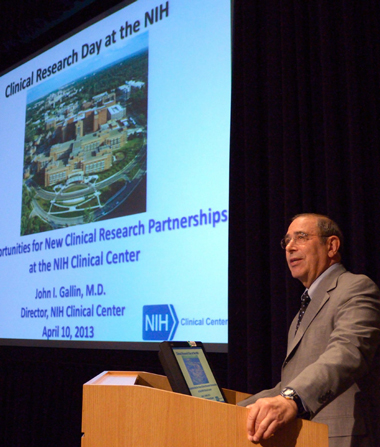 | |
| Dr. Gallin tells visiting researchers about the unique resources and opportunities available at the Clinical Center. | |
On a summery day in April, more than 100 trainees and early-stage clinical investigators from across the country and the NIH community attended Clinical Research Day. This open meeting highlighted the Clinical Center's expanded engagement with extramural investigators, and the extraordinary opportunities and resources available at the hospital for collaborative research. Another 145 participants watched the event via live webcast.
In response to the Scientific Management Review Board's 2010 recommendation that the Clinical Center "serve as a state-of-the-art national resource, with resources optimally managed to enable both internal and external investigator use," NIH has released a new funding opportunity. The NIH U-01 grant mechanism is aligned with the NIH's efforts to enhance the translation of basic biological discoveries into clinical applications that improve health. Research teams must have at least one extramural and one intramural co-principal investigator. As Clinical Center Director Dr. John I. Gallin noted in a recent guest editorial in the NIH Catalyst, this initiative "should bring new intellectual excitement to the intramural program while enabling clinical research projects that might not otherwise occur."
NIH Deputy Director for Intramural Research Dr. Michael Gottesman began the day by introducing NIH Director Dr. Francis S. Collins, who noted NIH's role as "a steward of medical and behavioral research for the nation," and highlighted its twofold mission: "Science in pursuit of fundamental knowledge about the nature and behavior of living systems; and application of that knowledge to extend healthy life and to reduce the burdens of illness and disability."
In his remarks, Dr. Gallin referred to the Clinical Center as an "enabling institute" that provides the resources to support collaborative scientific inquiry for the 26 other institutes and centers in optimal conditions that would be difficult if not impossible to duplicate in any other setting.
He noted that the Clinical Center's three main objectives are to 1) study the pathophysiology of disease 2) conduct first-in-human studies and 3) study rare diseases. He stressed the fact that "studies of rare disease provide hope for patients, but are also useful in identifying new molecular targets for treating common diseases."
Dr. Charles Dearolf, NIH assistant director for intramural research, spoke about the Lasker Clinical Research Scholars Program, which supports exceptional clinical researchers in the early stages of their careers by providing them with five to seven years of support as independent principal investigators at NIH, with the possibility of additional years of financial support either at NIH or at an extramural research institution. The Stadtman Investigator tenure-track positions and the opportunity for mentored research as assistant clinical investigators were also highlighted.
A full day of lectures, tours, informal discussions and other opportunities for the young researchers to meet and talk with NIH scientists about the work they are doing was broken up by a lunchtime break on the Southeast Patio. At one table several visitors talked over the morning's activities and what they had learned. "It's great to know that NIH is focusing on their mission—that they're doing what they set out to do, to improve health care," said Dr. Wen-Hsiang Lee, assistant professor of clinical ophthalmology at the Bascom Palmer Eye Institute at the University of Miami School of Medicine.
"NIH seems like one big family—people coming together for Grand Rounds, scientists coming together to solve big problems," said Dr. David Tompkins, assistant professor in the department of psychiatry and behavioral sciences at Johns Hopkins University School of Medicine.
Tompkins concluded, "It's good to know the NIH is there for me. I hope it will continue to be there to support young scientists. "
Links
- View the Clinical Research Day lectures
- Information about the U01 grants
- Lasker Clinical Research Scholars program
- Dr. Gallin's guest editorial in the NIH Catalyst
Did you know...
|
NIH geneticist's hunch leads to diagnosis for
a young stroke patient
 | |
| Almost-five-year-old Caelon Arthur and his family with Dr. Ivona Aksentijevich, whose diligent attention brought them from North Carolina to the Clinical Center, where they found the diagnosis they had been seeking for three years. | |
In clinical research, as elsewhere, "overnight success" is usually preceded by years of painstakingly slow progress toward a goal. Still, when it happens, it is exciting. So it was last month, when through a combination of diligent effort and serendipity, NIH researchers were able to diagnose a young patient whose case had his doctors stumped.
Dr. Daniel Kastner, head of the Inflammatory Diseases Section and Scientific Director of the National Human Genome Research Institute (NHGRI), is internationally known for his work investigating inflammatory disorders. Over the past 10 years, four pediatric patients referred to NIH for inflammatory problems shared a very specific complex of other symptoms, including fever and recurrent strokes.
The scientists in the Kastner group began to think there might be a genetic cause for these symptoms. By applying new genomic sequencing technologies they discovered that all four patients they were observing share abnormalities in the same gene.
Dr. Ivona Aksentijevich, one of the geneticists working on the case, suspected that there must be more children out there with this condition. "But we just couldn't find them," she says. For months she had been combing PubMed and consulting colleagues far and wide, in search of other patients who were experiencing the same unique set of symptoms—and finding nothing.
That is why she was so interested when she read a news story about a four-year-old boy, Caelon Arthur, who was experiencing multiple strokes, among other symptoms. She alerted Kastner, who urged her to contact Caelon's neurologist, Dr. Timothy Gershon, at the University of North Carolina School of Medicine. So she called Dr. Gershon. "We have four patients here who seem to have similar symptoms," she told him. "Maybe we can help."
One particular piece of information Aksentijevich gave Gershon made him hopeful that a diagnosis might be within reach. All four children in the NIH group had a distinctive rash called livedo reticularis—and so does Caelon. Gershon contacted Caelon's parents immediately, and advised them to call NIH. "They told us to come right away," says Jennifer Arthur, Caelon's mom.
Although Aksentijevich strongly suspected that Caelon's symptoms were caused by the genetic mutation they had recently discovered in their lab, DNA testing was required to confirm a diagnosis. Shortly after Caelon arrived at the Clinical Center, blood was drawn for the test: then everyone had to wait for the results.
That night, Aksentijevich was able to report to her colleagues that indeed Caelon has the same type of genetic mutation as the other four children. The following morning, Caelon's parents were informed of his diagnosis. Currently the NIH team is awaiting FDA approval to administer fresh frozen blood plasma to Caelon and the other patients in this small cohort, in an attempt to increase the protein levels depleted by the mutation.
For Caelon and his family, it was a whirlwind of events. "For the first time in three years, we got answers to our questions. It took NIH only 24 hours!" Caelon's mom said, a bit in awe.
"We've got a long way to go, but being able to diagnose is the first step," says Kastner. "Knowing what's causing the problem brings relief, perhaps even hope of an effective treatment." He adds, "What we will be able to learn about strokes from this newly discovered disease may also have implications for treating adult stroke patients."
"This is an amazing success story for the team at NIH," says Gershon. "I consulted experts all over the country—experts in child neurology, in pediatric strokes—and no one could come up with an explanation for what was happening. They're really doing remarkable work at NIH, that no one else could have done—and they've come to the aid of a child who needed help."
Learning about healing from patients with
life-threatening illnesses
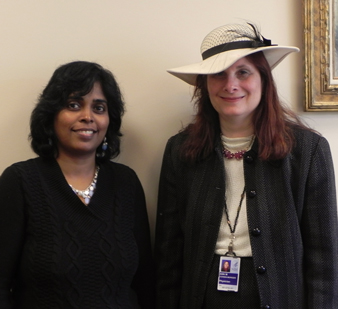 | |
| Dr. Ann Berger, chief of Pain and Palliative Care (right) and research fellow Sheeba Nadarajah (left) are creating a tool that measures spirituality. Berger often hosts tea parties for patients, at which she wears her signature hats. | |
There is a powerful mind-body connection that has been established: whether and/or how that connection can be used to promote healing is much less well understood or documented.
Dr. Ann Berger, chief of Pain and Palliative Care at the Clinical Center, who has herself experienced life-threatening illness not just once but three times in her life, is drawing on her work with cancer and cardiac patients to develop a tool to measure spirituality. This tool will help clinicians better understand the role of spirituality in healing, and thus make them better able to help their patients benefit from its healing power.
"The tools we have now ask patients, for example, if they are religious or spiritual, all in one question," says Berger. "That's a bad question, because many patients will answer, 'No, I'm not religious, I don't go to church.' But spirituality is so much broader than that. What about love of art, music, nature, animals, other people? All of that is included in spirituality as well. And all of these things can be used to promote healing."
Berger and her research fellow, Sheeba Nadarajah, are working on designing a tool that will help clinicians open conversations about the spiritual aspects of patients' lives rather than prematurely shutting them down, drawing on data they have gathered from interviews with patients who have life-threatening illnesses.
"Many of these patients undergo a positive, transformative change during treatment through a process that does not depend on uncommon heroics or courage," says Berger. "It is a matter of applying ordinary experiential learning in the midst of an extraordinary situation. The results can be extraordinary personal change and growth—or healing."
While to Berger this came as no surprise, Nadarajah confessed that when she was first engaged in this work, it surprised her. "How could cancer or a heart attack be positive?" she says. "And yet that is exactly how some of these patients describe their experiences with life-threatening illness. They say it was a positive thing in their life."
Berger and Nadarajah are currently compiling the data collected in interviews with cancer and cardiac patients. Eventually, they will collect data from all 50 patients in the protocol. After they have developed their questionnaire, it will be tested with a pool of 400 patients.
"People who are dying can get to meaning-of-life issues more quickly than the rest of us," says Berger. "And yet these are questions that affect us all. Anybody who goes though a crisis—divorce, loss of a job, loss of loved ones—anyone who experiences loss faces meaning-of-life issues. That's why this is so important. This work is not only applicable to patients with life-threatening illness. It is applicable to life generally. When faced with a crisis, the key question is, will you go through it successfully, or unsuccessfully? It's a choice."
NIH Clinical Center recognizes National Volunteer Week
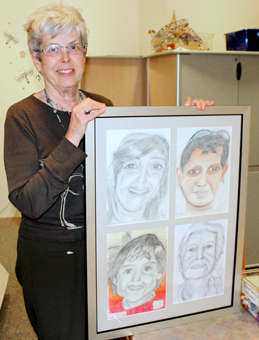 | |
| Susan Pearcy holds a patient drawing that won second place at The Children's Inn Gala Art Contest. Pearcy volunteers for the Recreational Therapy Program at the Clinical Center's Pediatric Unit. | |
This year, the Clinical Center Social Work Department honored the hospital's dedicated volunteers during National Volunteers Week, April 21-27. According to Courtney Duncan, volunteer program coordinator at the Social Work Department, Volunteer Week offers an excellent opportunity for the Clinical Center community to thank and recognize volunteers, while calling attention to all that they do to enhance patient services.
2013 marks the twentieth year of Susan Pearcy's volunteering career at the Clinical Center. Pearcy, who is among more than 150 volunteers stationed at the Clinical Center, decided to become a volunteer after she visited a friend who was being treated at NIH.
"It struck me how the NIH community felt like a 'city within a city'—there were families of all different nationalities in the waiting room. It then occurred to me that this would be an interesting place to volunteer," explained Pearcy.
As an artist, Pearcy introduces a variety of art materials, and drawing and painting techniques, encouraging the children's creativity. She is very proud of the achievement of one of the 1NW patients who won second place at the 2013 Children's Inn Gala Art Contest. "I've been privileged to witness the incredible spirit that lies within children—they teach me so much about resilience; facing challenges and fears; about living in the moment; reminding me to be grateful," said Pearcy.
In addition to her volunteering job at the Clinical Center's Recreational Therapy Program, Pearcy is a full time artist and works out of her Sugarloaf Studio in Barnesville, Md. She has exhibits throughout the DC metropolitan area and has been actively involved with the Children's Art Gallery at the Children's Inn, where children's art is displayed.
When asked what advice she would give to future volunteers, Pearcy said, "I encourage people to think about their strengths and where they could use their gifts best at NIH, and apply for a position at the Volunteer Office. It is a real privilege to be a volunteer at NIH."
Clinical Center earns CFC Chairman's Award
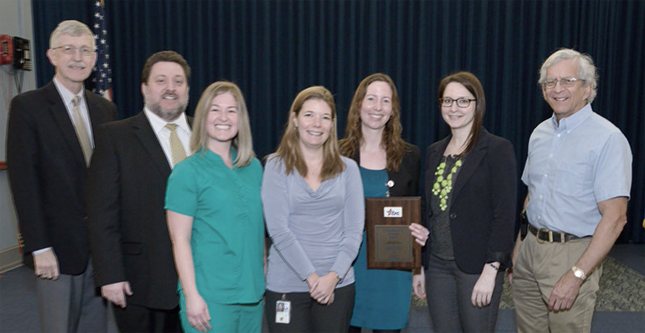
On March 7, the Clinical Center Combined Federal Campaign coordinators accepted the CFC Chairman's Award, denoting at least 70 percent employee participation or an average gift of $260 or more, for the Clinical Center's 2012 campaign. Accepting the award on behalf of more than 100 key workers who supported the campaign are Delisa Nash, Charlotte Pak, Rachael Schacherer and Lisa Ruprecht (women left to right). NIH Director Dr. Francis Collins, NIA Executive Officer Patrick Shirdon, and NIA Director Dr. Richard Hodes (men left to right) presented the team with the campaign's second highest honor.
In addition to receiving the Chairman's Award, the Clinical Center was also recognized by the CFC of the National Capital Area for hosting the Best Special Event (the 1st Annual CC Games of Thrones) among medium-sized agencies. In all, the Clinical Center raised over $170,000 for local, national and international charities, exceeding its goal by 22 percent.
Vicki Malick retires
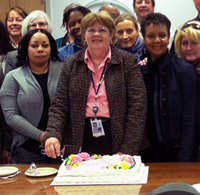
After 36 years of federal service, Vicki Malick retired on March 31, 2013. Malick served in the Clinical Center's Office of Clinical Research Training and Medical Education, coordinating both the NIH Clinical Electives Program for medical and dental students, and the NIH Resident Electives Program.
Malick was also instrumental in the development of the Intramural Program on Research on Women's Health and the Women's Health Scientific Interest Group under the direction of the NIH Office of Research on Women's Health.
Nurses honored for 35 years of service
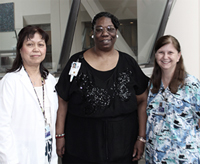 The Nursing Department at the Clinical Center honors staff for their length of service and their commitment to the research missions of the NIH.
The Nursing Department at the Clinical Center honors staff for their length of service and their commitment to the research missions of the NIH.
Nurses recognized for 35 years of service are (left to right): Delores Medina, CRN Outpatient Clinic 9; Senora Mitchell, Nursing Program Support Staff; and Lori McIntyre, CRN Inpatient Unit 3NW.
Upcoming Events
Medical Research Scholars Program
Year-end Scientific Presentations
May 13, 8:30 a.m. to 5:30 p.m.
May 14, 8:30 a.m. to 5:00 p.m.
Lipsett Amphitheatre, Building 10
Scholars will deliver their year-end scientific presentations. Each fellow will present a 15-minute formal lecture on his/her clinical, translational, or basic research to the NIH community and other special guests. Topics and schedule are available at http://www.cc.nih.gov/training/news_events.html.
Bike to Work Day
May 17
7:00 – 9:00 a.m.
Building 1 Pit Stop
Help NIH secure its title as the DC area's top employer for bicycle commuters. NIH invites all bicyclists to enjoy this fun and healthy activity. Refreshments will be provided for all participants at the Building 1 Pit Stop. Open to all commuters. Don't forget to wear your helmets!
http://www.biketoworkmetrodc.org [disclaimer].
2nd Annual
I ♥ Clean Hands Day!
Information Fair & Expo
May 21
10:00 a.m. – 1:00 p.m.
Building 10 Atrium
The Clinical Center Hand Hygiene Isolation Innovation Team is organizing "I ♥ Clean Hands Day!" to raise awareness of the importance of hand hygiene among staff members, patients and their families. Activities include a fact-fiction game wheel, a hand hygiene poster contest, and booths for handwashing demonstration, microbiology, and fun crafts. The event is open to all patients and staff.
Create your own poster!
Enter a poster that promotes good hand hygiene in the hand hygiene poster contest. All are encouraged to participate and vote for their favorite poster.
Submit your posters to Sima Zadeh (zadehsl@mail.nih.gov) by May 14. Winners will be announced during the event on May 21 at 1:00 p.m.

 The information on this page is archived and provided for reference purposes only.
The information on this page is archived and provided for reference purposes only.